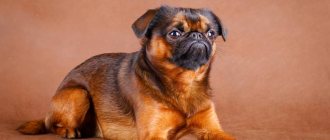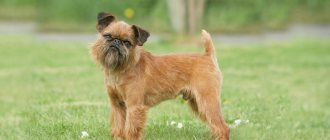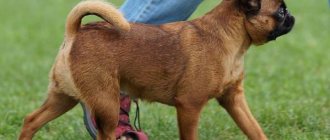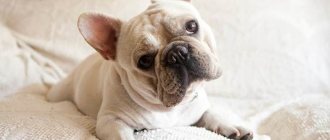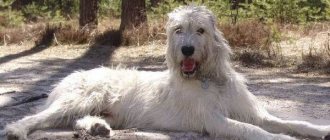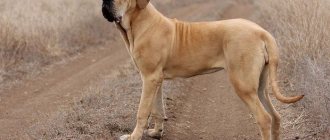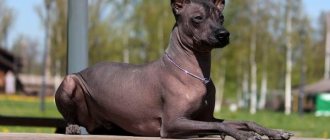History of the Brussels Griffon breed
Brussels Griffon
Brussels Griffons appeared in Belgium about two centuries ago, although indirect references to the breed date back to the first half of the 15th century. Thus, the “Portrait of the Arnolfini Couple” by the early Netherlandish painter Jan van Eyck depicts a small shaggy dog that looks like a Brussels Griffon. The similarity of the animal with a modern representative of the breed can also be seen in a later painting by the German artist Johann Zoffany. It shows the children of the British King George III playing with light beige dogs that look like griffins. The Frenchman Pierre Auguste Renoir created a masterpiece called “Nude with a Griffon”, where there was also a place for this amazing animal.
Contrary to popular belief, the name of the breed does not come from a mythological creature with the head of an eagle and the body of a lion. The word "griffon" is of French origin and is translated as "wire-haired".
The favorable climatic conditions of Belgium obliged its inhabitants to actively engage in agriculture. Wild rodents, distinguished by their amazing gluttony, became frequent visitors to the barns where grain was stored. After a dozen of their barbaric raids, the Belgians could lose their crops before the onset of winter cold. To successfully combat pests, a new breed was developed - small shaggy dogs that could easily penetrate hard-to-reach places and expel uninvited guests. Outwardly, they differed from modern animals, but the similarities were obvious.
It is worth noting that the breeding program has become quite fruitful, giving the world three varieties of griffons:
- Belgian - direct descendants of Affenpinschers;
- Brussels - a cross between Affenpinschers and Cavalier King Charles Spaniels;
- Brabant (Petit Brabançon) is the result of mating Cavalier King Charles Spaniels and Pugs.
Breeders allow the crossing of three lines with each other. Adult dogs differ only in color and coat type. This is indirectly confirmed by cases of births of representatives of all types of griffons within the same litter.
Petit Brabançon
The fate of the little rat catchers changed dramatically in the second half of the 19th century. Then the griffons attracted the attention of representatives of the nobility. Even the Belgian Queen Marie Henriette admired these dogs. She supported the breeding of animals and played an important role in the spread of the breed throughout Europe. Increasingly, noble ladies accompanied by griffins appeared at dinners and balls. Some used these dogs to guard carriages: the sonorous barking of the kids immediately attracted attention.
There is a well-known story with a sad ending associated with the Brussels Griffons. Thus, Queen Draga of Serbia was obsessed with the idea of poisoning, so before each meal she shared a portion of food with her pet. One day, after taking another bite, the griffon fell to the floor dead. The queen's suspicions were confirmed, but at the same time she lost her faithful pet.
Brussels Griffons were not distinguished by their pretty appearance. Their popularity was due to the enthusiasm of their owners, who appeared at various shows and exhibitions with their shaggy pets. The first appearance of griffins took place in 1880 at an exhibition organized in Brussels. Noticing the public's interest in charming bearded dogs, dog lovers united and founded the Royal Society of St. Hubert in 1882. Soon its members began maintaining the studbook of the breed, which at that time had a different name - the small Belgian wire-haired terrier.
Such an active strategy was crowned with success: already in 1904 the first breed standard was adopted. Six years later, Brussels Griffons were included in the official registry of the American Kennel Club (AKC). In 1920, the Orleans Volcano kennel, owned by Miss Ionides, numbered about 40 representatives of the breed. Most of the dogs were brought from France and Belgium. Ten years later, the woman acquired new griffons from the Nunsoe nursery. With the beginning of the military events of the 20th century, Ionides took care of the export of her charges to Great Britain.
Black Brussels Griffon
Beige Brussels Griffon
In 1926, the first alarm sounded: representatives of the breed were exported less and less from Belgium. After the end of World War II, the number of dogs decreased completely. They mainly lived in the USA and Great Britain, but were much less common in their homeland. In 1945, the first American breed association appeared. After 11 years, Brussels Griffons were recognized by members of the United Kennel Club (UKC). In 1963, breeders finalized the previous standard. It is this version that is still valid today.
Despite the efforts of dog breeders, the breed remained scarce. Thus, during 1993, the French stud book registered only 25 cases of griffon births. Even now, meeting a representative of this breed is a rare success. The Brussels “bearded dogs” have not gained significant popularity, but still have gained the love and admiration of dog handlers around the world due to their extraordinary appearance and good-natured character.
Appearance of the Brussels Griffon
The Brussels Griffon is a decorative breed. It cannot be called a lap dog, meaning a cute and docile pet. Griffons are known in Belgium as street dogs: rough and stocky, with unruly, coarse hair and a “human” expression in their eyes.
The breed standard defines the following parameters: height at the withers – 27-32 cm (for males) and 25-30 cm (for females); body weight – from 3.5 to 6 kg. “Boys” look stronger and stronger: the sexual type is well defined.
Head and skull
The head of the Brussels Griffon has a rounded outline and looks large in relation to the body. In comparison with the convex forehead, the brow ridges and the occipital protuberance are inconspicuous. The skull is round and large.
Muzzle
Brussels Griffon muzzle
Brussels Griffons have a very short and upturned muzzle. Its length usually does not exceed 1.5-2 cm. The stop is deep: the frontal part abruptly turns into a small bridge of the nose. The short nose is notable for its wide nostrils, divided by a groove, and pigmented black. When examining a dog in profile, the tip of the nose and forehead form a line. When viewed from the front, you can see that the animal's eyes and nose are located at the same level. Dry and tight-fitting lips have a dark border. Despite the fact that the upper lip completely hides the lower jaw, there are no so-called pockets in the corners of the mouth. The teeth and tongue are not visible when the dog's mouth is closed. The chin protrudes forward, slightly raised. On the fur of the muzzle there is a “mask” that is a tone or two darker than the main color of the coat.
Ears
The Brussels Griffon's ears are small, set high on the top of the head and at a considerable distance from each other. Located in a semi-standing position with a slight tilt forward. The standard allows cropping of the ears: in this case, they become pointed and slightly raised.
Eyes
The eyes are set wide and on the same line. They are quite large in size; rounded, but not convex. The griffon’s look is characterized by “humanity”, which is why even puppies seem wise from life experience. The eyelids fit tightly, completely hiding the whites of the eyes and the so-called third eyelid. “Decorated” with long eyelashes, which creates the effect of a black edging. The preferred color of the iris is brown; the darker the shade, the better. The look is expressive and lively.
Jaws and teeth
The lower jaw of the Brussels Griffon is U-shaped, slightly curved upward, forming an undershot. The incisors are located on two parallel lines, the fangs are spaced quite widely. A complete dental formula is required. When the dog's mouth is closed, the tongue and teeth should be hidden.
Exhibition Winner
Neck
The animal’s strong neck does not look weighted, despite its high posture and “bulge.” Medium length, distinguished by lean muscles.
Frame
Brussels Griffon puppy
Brussels Griffons have a square body format: the height of the dog at the withers coincides with the length of the body. Due to the developed bone, it seems that the animal’s chest protrudes forward, like that of a hussar proudly wearing his uniform. Rounded ribs do not create a “barrel” effect. The dog's withers are moderately expressed. The long shoulder blades are pressed tightly together. The back of griffons is muscular and strong, extending into the lower back (its line is slightly raised upward). The croup is sloping downward. The stomach is tucked, the groin is defined.
Tail
The tail of the Brussels Griffon is characterized by a high carriage. It is carried raised, the tip “looks” at the back, but does not curl or touch it. It is acceptable to dock the tail by 2/3 of its original length.
Forelegs
They are distinguished by prominent muscles and strong, well-developed bones. “Brought out” under the body of the animal, placed parallel and at a considerable distance from each other. Elbows pressed tightly under the withers. Sheer forearms flow into short pasterns. The griffon's limbs end in small round paws with gathered toes. The pads and claws are pigmented black.
Hind limbs
Placed in such a way that they slightly protrude beyond the ischial tuberosities; the angles of the articulations are moderately developed. Strong thighs are notable for their sculpted muscles. The hock joints are located low above ground level, leading into strong metatarsals. The feet are round and arched, ending in hard pads and claws painted black.
Movement style
Brussels Griffons move at a trot. The hind limbs provide a powerful push, while the front limbs are thrown forward moderately. When moving, the back remains straight and level.
Grace is my middle name
Coat
The guard hair is medium length, thick and wiry - the rougher it feels to the touch, the better. Around the dog's eyes, near the nose, on the cheeks and chin, the hair is longer, forming “vegetation” on the face: eyebrows, sideburns, mustache and beard. Needs manual trimming.
Color
The Brussels Griffon breed standard provides for the following color options:
- red with a brownish “mask” and dark decorating fur;
- beige with a brownish-red or black “mask” and dark decorating hair;
- solid black (adult dogs show gray hair).
Possible defects
A true gentleman
The slightest deviations from the standard are considered defects. Among the common ones are:
- stretched or shortened body format;
- silky and soft coat;
- slanted and/or light-colored eyes;
- light or rough physique;
- pointed and/or drooping muzzle;
- aggressive or cowardly behavior;
- sloppily trimmed fur;
- sharply sharp or straight angle of the croup;
- hunchbacked or sagging lower back;
- brown pigmentation of claws;
- barrel chest;
- flat and/or narrow head;
- presence of dewclaws;
- low neck;
- undeveloped muscles;
- excess body weight;
- white guard hair;
- narrow withers and back;
- straight bite.
Disqualifying faults of the breed are:
- partial or absent pigmentation of the eyelids, nose and lips;
- white spots or “holes”;
- brown nose;
- light pigmentation of claws;
- loosely closed mouth;
- dislocated joints;
- undescended testicles;
- lameness;
- undershot;
- deafness;
- blindness.
Breed characteristics
Despite the fact that griffons have small body sizes, they are very brave dogs. A devoted pet will, without any doubt, rush to protect its owner, no matter what threatens him, even if the enemy is several times larger than the “Belgian”. These cute dogs also have good security qualities and will listen carefully to every rustle coming from outside the apartment’s front door.
Griffons are not very trusting of strangers, preferring to simply shyly hide behind their owner’s legs. If a stranger pets a dog, the animal will try to dodge and sometimes grumble in displeasure, but will never show aggression.
"Belgians" are perfect for family keeping. Dogs love absolutely all family members, including other furry inhabitants of the apartment. They get along great with children. But it’s better not to leave such a dog with very young children. Children are often very careless when playing with animals and love to hug and cuddle their pets. For a griffon weighing 2-3 kg, such games can end tragically; a decorative dog can easily break a leg or even a spine. Therefore, you need to get a pet of this breed when the rules of behavior with animals can be explained to the younger generation in the family.
The Belgian Griffon is very attached to people. As a rule, a pet singles out only one family member and completely obeys him, considering the owner to be the leader of the pack. But it is worth considering that with improper upbringing and permissiveness, the pet may try to take the place of the leader himself. Therefore, you should not allow a dog, even one as cute as a griffon, to sleep in the place of its owners, and also not to feed the animal ahead of the rest of the family. Owners of “Belgians” must realize that, first of all, this is still a dog and it must be raised according to all the rules.
Griffons love active walks; a half-hour walk is not enough for the animal, even if the owner takes it outside 3-4 times a day. Each walk should last at least an hour. The dog needs to be let off the leash so that it can run around and have fun. For active people, the Belgian Griffon is just a godsend. This creature will happily accompany its owner absolutely everywhere, be it a morning (evening) jog in the park or a regular shopping trip.
The Belgian Griffon is a very people-oriented dog. These bearded four-legged creatures simply cannot stand loneliness and suffer greatly if they are left at home alone for a long time. At such moments, the dog becomes very bored and may whine and bark incessantly. Therefore, it is extremely undesirable for a person who is always missing at work to have this breed. In addition, “Belgians” become so attached to their owner that when they are transferred into the wrong hands, the animal may simply not get used to the new owner.
Griffons are very clean creatures. They will be happy to let you wash their paws after a walk outside or wipe their faces from leftover food after a delicious lunch. These small four-legged creatures are very smart and quick-witted, so teaching them various commands and tricks will not be difficult. By taking a responsible approach to raising a puppy, you can soon get the best dog that will be the joy and pride of the whole family.
Photo of Brussels Griffon
Character of the Brussels Griffon
Representatives of the breed look like stern and unsociable bearded men, but upon closer communication with them it is easy to understand that the first impression is still deceptive. Brussels Griffons are energetic and sociable dogs that love to be the center of attention. You should be careful with the latter: it’s easy to raise these kids into capricious and demanding pets who won’t leave you alone until they get what they want.
Surrounded by love
Owners of griffons refer to their pets as “tails.” Indeed: animals are accustomed to following their owner’s heels and, at the first opportunity, “kissing” him half to death. Four-legged people from Brussels are inclined to support any, even the most extravagant idea. A spontaneous trip to the river bank in the early morning? All paws are in favor! An unexpected trip to the ends of the world? Better! No matter how tired and sleepy the “Brussellian” may be, he will not grumble in response to the offer to actively spend time and will find the strength for a long-awaited walk.
Living in a large family, the griffon considers only one person his equal. The rest will have to try hard to earn at least minimal trust from the dog. And it’s not even worth talking about selfless love: winning the heart of an obstinate baby can take more than one month.
Although Brussels Griffons are self-confident, they need the company of their owner and do not tolerate loneliness well. This breed is not suitable for people who spend a significant part of their time at work. The “Brussellian” will not be the best friend of someone who is not accustomed to obligations to a living being. The animal tends to impose its company, which not every person will like.
There is an opinion among beginners that decorative dogs do not need long walks. This is not the case with the Brussels Griffon: representatives of the breed love to explore their surroundings under the close supervision of their owner. Of course, a half-hour promenade is enough for animals, but if you manage to stay outside as long as possible, your pet’s happiness will know no bounds! It seems that under the fur, which is harsh to the touch, there is a small motor hidden that sets the dog in motion, forcing it to frolic in the fresh air.
Despite its modest dimensions, this breed is famous for its protective qualities. A small “bell” will notify the owner of the approach of an uninvited guest. Of course, you shouldn’t expect zealous protection of property from a griffon, but still rest assured: not even a fly will fly past the vigilant “bearded man” unnoticed.
“Brussels” need early socialization, otherwise the dog will become fearful or aggressive at the sight of strangers. Even properly raised griffons are wary of strangers. A typical representative of the breed will not wag his tail in vain if others sincerely admire him. Instead of barking loudly and joyfully, the animal will growl and take a step back. It is unlikely that a stranger will be able to pet the baby.
Friendship with a cat
Families with children should consider other breeds. Brussels Griffons are not known for their patience with childish games, will not tolerate rough pushing, and may even bare their fangs if they see danger in a child’s actions. In addition, these small dogs are quite fragile and require appropriate treatment. Unfortunately, not all children are careful with pets.
Representatives of this breed easily find a common language with their relatives. If you already had a dog in your house before the Griffon appeared, the Brussels “bearded man” will happily recognize the authority of his older friend and will even begin to copy his habits. However, some kids will still try to take the place of alpha. The owner’s task is to stop possible aggression. This rule also applies to other pets: cats, ornamental rodents and birds. A socialized griffon is tolerant of animals, but in any case will jealously guard its toys and treats.
Brussels Griffons are not suitable for keeping in an aviary - this is a fact. Small pets love a cozy, draft-free apartment. Set up a secluded place for your dog, set aside about an hour and a half for a walk every day, get out of town more often - and the Brussels Griffon will be the happiest!
Character
The Vendeans are hounds, and natural born hounds at that. They succeeded not only in speed and speed of running, but also in endurance, because they are able to pursue prey for many hours during a hunt, moving both in a group and individually. However, such dogs are not at all distinguished by a ferocious disposition, but are famous for their curiosity, intelligence, cheerfulness and affectionate attitude towards people.
If these dogs are well trained by their owners, they become ideal pets. But in the absence of sufficient education, many shortcomings can appear. And the most important of them is extreme and unbridled activity.
Their natural hunting qualities are capable of demonstrating their negative sides if, mistaking some object for their prey, they rush after it without permission, or worse, attack it. And the desire to protect their patrons can cause unreasonable aggression towards strangers.
Another disadvantage of dogs is often their proud, independent disposition, which manifests itself in the desire to dominate their owners. Feeling their weakness, such dogs show disobedience, wanting to insist on their own. They are seeking the right to decide for themselves what and how to do.
Stubborn people allow themselves to chew on valuable objects in the room, sleep where they want, and eat what they want. Therefore, they should be taught discipline and obedience from puppyhood. In the photo, the Vendean Basset Griffon looks very cute. It should be remembered that it depends only on the owner whether he will be well brought up.
Education and training
In addition to the appearance of a wise old man, the Brussels Griffon is also notable for its inquisitive mind. Even two-month-old puppies easily understand what is wanted from them, so their education should begin as early as possible. First, clearly define the position of the leader: the griffon should not allow the idea that he is the head of the family. Brussels tend to be dominant, so this breed is not suitable for people with a soft character.
Although Griffons have a reputation for being quite intelligent dogs, they can be difficult to train. The animal often shows stubbornness and willfulness, so training will require a lot of time and effort. At the same time, the Brussels Griffon is one of the most trained miniature breeds. It’s worth starting by learning the basic commands: “Sit!”, “Lie down!”, “Voice!”, “Come to me!”, “Give me your paw!”, “Near!”, “You can’t!” If necessary, you should seek the services of a professional dog handler.
During the training process, use your main weapons - consistency and patience. Use only positive methods: treats, encouragement, or affectionate stroking behind the ear. It is not recommended to raise your voice at a dog: after such humiliation, the griffon will not soon be in a training mood.
In addition to teams, it is worth involving the Brussels Griffon in individual sports - in particular, agility. During the obstacle course, the animal will not only repeat the commands it has already learned, but will also stretch its paws to its fullest. In addition, communication with the owner and four-legged relatives will only be beneficial.
How to feed your pet
Belgian Griffons are not prone to obesity, despite the fact that the dogs love to eat and will constantly beg their owner for a tasty morsel. You should feed your four-legged pet only with premium food; cheaper options will not work. You should not overfeed your pet, as this can lead to vomiting and diseases of the gastrointestinal tract.
If the owner decides to feed his pet natural food, then you should pay attention to the following list of products:
- Cereals.
- Vegetables.
- Fermented milk products.
- Chicken, turkey.
- Beef, lamb.
- Fruits.
The dog simply cannot tolerate sweet, smoked, spicy foods, as well as sausages. In addition, the animal is prohibited from giving milk, legumes and small bones. Griffon puppies are fed at least 4 times a day, adult dogs - in the morning and evening. In the summer, the amount of food is reduced. Bowls with food must be placed at the level of the dog's chest, otherwise the animal may have digestive problems and problems with the spine.
Care and maintenance
Post-washing
Due to their specific coat, Brussels Griffons require constant and careful care. The dog should be combed at least once a week (preferably more often), using a fine-tooth comb or a furminator. A special “studded” mitten is also suitable: these are sold in pet stores. Whiskers, mustaches and beards should be brushed daily to keep the hair from tangling and looking neat. Representatives of the breed also need regular trimming - plucking hairs. It is advisable to entrust this procedure to a specialist, especially if your pet plans to participate in an exhibition.
Representatives of the breed do not need regular water treatments: this negatively affects the condition of the coat. It is enough to bathe the dog as needed, but not more than twice a month. Pay attention to the composition of the zoo shampoo: it should not contain aggressive substances. Before bathing, dilute the hygiene product with water in a ratio of 1:3. Rinse off the shampoo thoroughly, especially from the decorative hairs on the animal's face. After bathing, just wipe the griffon's coat with a towel made of natural material that absorbs moisture well. Make sure there are no drafts, otherwise the dog may catch a cold. The ideal place to relax after taking a bath is a dry and warm room.
It is important to know: small skin folds on the Brussels Griffon's face are a favorable place for the proliferation of pathogenic bacteria. Be sure to check them after every walk or meal. This way you will avoid forced visits to the veterinary clinic.
Fashionable haircut
The trimming procedure is also necessary for the Griffon's ears: the thick fur in the shells prevents good ventilation. To soften sulfur and carefully remove it, it is recommended to use products with a drying effect.
Your dog's eyes should also be examined regularly. Their convex shape contributes to irritation due to long hairs, so areas of the body above the nose must be trimmed carefully. The hairs are removed towards the inner corner of the eyes. Remember that heavy discharge is an alarming signal: you need to eliminate the problem as soon as possible, otherwise veterinarian intervention will be required.
The oral cavity is another favorable environment for the growth of bacteria. The owner of a Brussels Griffon should take care to regularly remove plaque from the pet's teeth. The frequency of the procedure can be reduced if the dog eats dry food: in this case, cleaning is carried out involuntarily. The owner's intervention will only be required once a month. Animals that eat natural food will have to brush their teeth from puppyhood. To do this, you need to purchase a special paste at a pet store. You can “please” the griffon with a hygiene product that tastes like fish or meat. Some dog owners recommend rubbing their pets' teeth with activated charcoal, which slows down the formation of plaque.
The Brussels Griffon is a very active breed; the claws of its representatives most often grind down on their own. Sometimes this does not happen, and the animal begins to experience discomfort. This is where a special nail clipper for small dogs will come to the rescue. Trim the griffon's claws carefully, avoiding areas with blood vessels. Don't hurt your pet, otherwise next time he will do anything to avoid falling into your hands.
What's for lunch?
Nutrition is an important point in keeping Brussels Griffons. When acquiring a new friend, it is worth consulting with the breeder regarding the dog’s previous diet: it is strictly not recommended to change it suddenly. You need to gradually transfer your pet to a new type of food, monitoring the well-being of the griffon. Representatives of the breed often exhibit allergies.
There are two diet options: dry food and natural food. When choosing the first one, you should consult a veterinarian and carefully read the recommendations on the package. Super premium or holistic food is ideal. This method of eating will save a lot of time.
The natural diet of the Brussels Griffon should include raw or scalded meat, boiled sea fish without bones and cereals (oatmeal, buckwheat, rice). Dog handlers recommend supplementing the dog’s menu with seasonal fruits and vegetables, low-fat dairy products and quail eggs. Once a day, add a teaspoon of vegetable oil to the main “dish”.
Should be excluded:
- spicy, salty, pickled food with spices;
- “human” drinks (tea, coffee);
- fatty meat (pork, lamb);
- river fish in any form;
- cow's and mare's milk;
- carbohydrate products;
- smoked delicacies;
- berries with seeds;
- legumes;
- tubular bones;
- sweets.
It is necessary to provide the dog with constant access to clean water. Owners advise using bottled. Infused tap water will also work.
Ready to walk in the rain
In general, Brussels Griffons are unpretentious. Although they require three walks a day, you can teach the animal to relieve itself in a specially designated place (for example, on a diaper) and thereby reduce the time of the promenade. Some owners of bearded dogs like to dress them in nice clothes, but in general this cannot be called a necessity. The exception is slush: due to its short stature, the griffon can get pretty dirty, so he will need waterproof overalls.
Having acquired a little friend, you need to highlight a secluded corner. Otherwise, the griffon will hide from prying eyes under the bathtub or bed, on the lower shelves of cabinets and even in open bedside tables. The animal will also hide its “treasures” there: slippers, toys, socks, pencils, pens and other items that, in its opinion, have lost their value for the owner. Having taken a little fluffy into your home, you will have to accustom yourself to order if you do not want to lose many things. By the way, for such a funny habit, Brussels Griffons are often called brownies.
Despite its modest size, the Griffon's snoring can be compared to that of the English Mastiff. This is due to the flattened muzzle, which causes breathing to be excessively loud. For sound sleep and good health in the morning, it is recommended to organize a personal place for your pet far from your bedroom.
Dog care
The small Belgian dog requires special care. First of all, the owner must provide the pet with a separate place in the apartment, which will be the dog’s personal space. It is advisable that this be a small, secluded corner where the animal can hide its “treasures”: the owner’s socks or slippers, children’s toys and other things that do not lie well on the floor.
Particular attention should be paid to the dog's fur. Griffons have a hard and thick coat that will require regular grooming. It is recommended to comb your pet daily with special brushes, and during shedding (2 times a year) to trim the dog, that is, comb out the old fur while the new one is renewed. You need to wash your four-legged friend as needed, but not more than once every 3 months. For washing, use special shampoos intended only for animals. If you carry out water treatments constantly, your dog's skin will lose a layer of sebum, which serves as a protective barrier against harmful microorganisms.
Griffons, due to the nature of their coat, tolerate heat very poorly. For a dog to live comfortably, its owner must ensure that the apartment is not too stuffy. In addition, you should not leave your pet in a car with the windows closed, even for a short time, as there is a high risk of the dog dying.
Every Belgian Griffon owner should carefully monitor the condition of the dog's claws. As soon as white tips appear on the claws, they are carefully cut off, trying not to touch the nerve. Don't forget about cleaning your ears and taking care of your teeth. Tartar is very harmful to the health of the oral cavity, and also makes the dog uncomfortable when eating. For effective stone removal, it is recommended to consult a veterinarian.
Like any other breed of dog, the Belgian Griffon must be regularly treated for ectoparasites and helminths. Many owners love to kiss their pet's wet leathery nose, but if the dog is not treated for worms, this can be dangerous for its owners.
Health and diseases of Brussels Griffons
Representatives of the breed are distinguished by strong immunity to viral and colds. However, dogs are characterized by common pathologies:
- hydrocephalus (water on the brain);
- distichiasis (presence of extra eyelashes);
- loss of eyeballs;
- complications during childbirth;
- cyst in the spinal cord;
- retinal atrophy;
- Perthes disease;
- narrow nostrils;
- cataract.
Daily walks, age-appropriate feeding regimen, timely vaccination, treatment for parasites - these are the keys to the longevity and health of your pet. If suspicious symptoms are detected, you must make an appointment with a veterinary clinic.
Common diseases
Despite their strong build and endless energy, small Belgian dogs suffer from many diseases, including hereditary ones. The most common ones are:
- distichiasis (growth of eyelashes near the eyeball, constantly leading to injury);
- prolapse of the eyeball;
- narrowing of the nasal passages;
- retinal atrophy (progressive);
- cataract;
- hydrocephalus of the brain.
Female griffons have a very difficult time with the birth process due to the narrow birth canal, so birth in these small dogs takes place only in the presence of a veterinarian and usually ends with a cesarean section.
Little “Belgians” are susceptible to various viral infections, so it is very important to vaccinate animals in a timely manner. Under good conditions, dogs live for at least 13-15 years, but there are cases where griffons have delighted their owners for 20 years or more.
How to choose a puppy
Before purchasing a Brussels Griffon, it is important to create suitable conditions for keeping your future friend. A bed, bowls, toys, harness, dog hygiene products - only after purchasing these necessary things should you start looking for a kennel. Breeders who specialize in the breed are mainly located in large cities. If you live on the periphery, carefully consider the return journey - already in the company of a four-legged friend.
How do you like my bite?
Once a suitable Brussels Griffon kennel has been found, you can begin to select the gender of the puppy. Remember that males are distinguished by independence and a tendency to aggression, and females are distinguished by obedience and devotion. The latter can create additional discomfort during estrus: while walking with your pet, it is unlikely that you will be able to hide from the crowd of four-legged “suitors.”
If you have already decided on the gender of your future pet, it’s time to take a closer look at the candidates! The optimal age for purchasing a puppy is 6-8 weeks. Babies who are torn away from their mother early in most cases grow up weak and unadapted. In addition, the mental state of such a griffon leaves much to be desired: the puppy lacks primary socialization skills.
When choosing a Brussels Griffon, take a close look at the entire litter. If the kids are mostly shy or even aggressive, ask the breeder to introduce you to another dog family. Healthy Brussels cats should be curious, playful and cheerful. This is easy to check: take a bunch of keys or a rattle in your hand and extend it towards the puppies. Babies who feel great will immediately be attracted to a new sound and smell.
Pay attention to the griffon's build. You should not choose the most well-fed puppy, but excessive thinness of the animal should also alert you. Give preference to a medium-sized baby, carefully examine it from all sides. The coat should be thick, without bald spots; eyes and ears – clean; paws - undamaged. A healthy Brussels resident should not cough or sneeze.
The last step on the path to selfless friendship with the griffon is obtaining documents. A conscientious breeder must provide the buyer with a vaccination certificate for the puppy, his passport and proof of pedigree. It is worth asking him in more detail about the maintenance of Brussels Griffons, and especially about the diet of the chosen baby. For positive adaptation, it is not recommended to suddenly change the puppy’s diet.
Brussels Griffon puppies
Brussels Griffon price
A Brussels Griffon with elite origin and good health will cost the future owner 40,000 rubles.
The price can vary in any direction, based on several factors: the location and popularity of the kennel, the age and gender of the dog, titles and awards of its parents. For a lower cost – about 15,000 rubles – you can buy a “Brussels” from your own hands, but in this case no one guarantees the health and good immunity of the dog. No matter how much you have to pay for a griffon, it's nothing compared to what a loyal and cheerful friend you'll get! A representative of this breed will bring some fun to even the most monotonous everyday life.
Price
How much a puppy of this breed will cost the intended owner depends on the quality of its purebred. The most expensive dogs are show class dogs. From birth they are intended for breeding and improving the breed, participating in exhibitions to receive prizes and titles.
These puppies almost perfectly meet all the required standards. And their ancestors for several generations were recognized as purebred, as indicated in the pedigree. In these cases, the price of a Vendeen Basset Griffon can reach up to 100 thousand rubles and rise significantly higher.
Basset Griffon Vendeen large
Puppies with a slight discrepancy with the necessary characteristics, for example, with some arching of the back, which should, as already indicated, be straight; due to overly thick bangs, curly hair or inappropriate ear size, they lose a lot in price and cost buyers about 35 thousand rubles. But if there are serious discrepancies with the standards, then the dogs can cost even less – about 10 thousand rubles.



